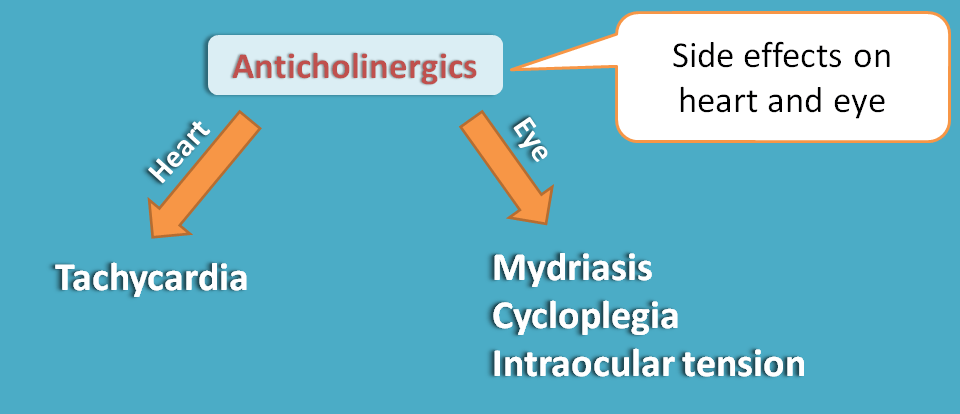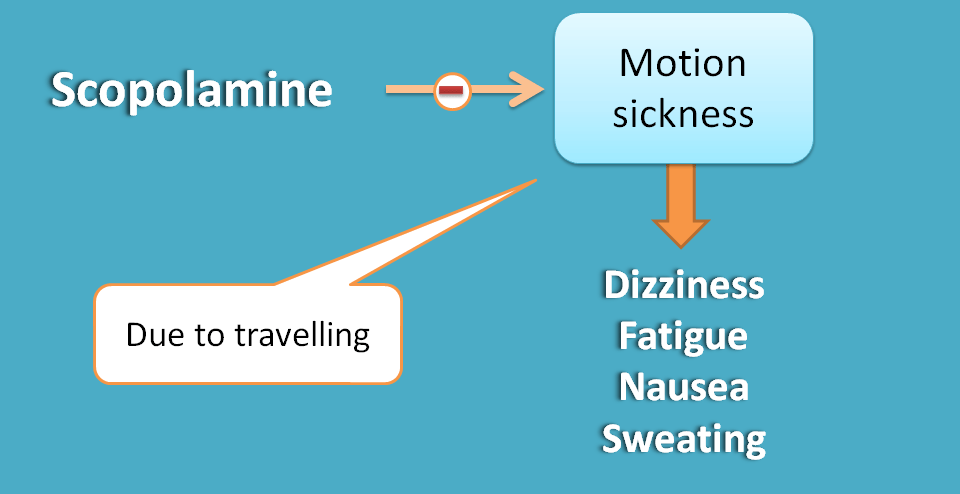Side effects and uses
Side effects
Obviously side effects are related with the pharmacological actions of muscarinic antagonists.
First let’s list out four side effects commonly called as anticholinergic side effects. You can easily remember these as “BCD for U”.
- B – Blurred vision
- C – Constipation
- D –Dry mouth
- U – Urinary retention

These side effects are also observed with other category of drugs like antihistamines and antipsychotics having additional anticholinergic action.
Potential drug interaction in OTC drugs.
Dry mouth and blurred vision are due to inhibition of salivary and lacrimal secretions respectively.
Constipation is produced by decreased GI motility due to GI smooth muscle relaxation. Frequency of urination is decreased due to bladder relaxation leading to urinary retention.
Other side effects include
- Tachycardia
- Increased intraocular tension
- Mydriasis
- Cycloplegia

Drugs like atropine can cross the blood brain barrier and may produce central effects like
- Confusion
- Restlessness
- Hallucinations
- Delirium
Hyoscine can produce short term amnesia and sometimes it is used intentionally to produce amnesia.
What are the toxic symptoms?
Where they indicated?
Anticholinergics can be indicated in various situations as
- Mydriatics
- Preanesthetics
- Antiemetics
- Antispasmodics
- Anti-ulcer agents
- Bronchodilators
- Anti-parkinsonian agents
- Bladder relaxants
Let's see one by one.
Mydriatics
Cyclopentolate and tropicamide produce pupilary dilatation along with cycloplegia are used for this purpose. They have duration of action as 6 hr and 24 hr respectively.

Atropine can also produce mydriasis but less preferred due to long-term action and central side effects.
Preanesthetic
As anticholinergics inhibit glandular secretions, they can be given before the surgery to dry all the secretions. Atropine is used for this purpose.
Antiemetics
Suppose you are on a rotating chair and it was rotated at high speed, you will get a feeling of some dizziness and nausea. This is due to rapid rotation where sensory information from your eye in not matched with that from your inner ear. This is natural that any person can feel these symptoms when rotated at high rate. But in few patients these symptoms can be observed when they travel even at normal speed and it is called as motion sickness.

Motion sickness is a feeling of dizziness, fatigue, sweating and nausea due to movement generally by a vehicle during travelling. Hence it is also called as travel sickness. Scopolamine can decrease the vomiting reflex and hence indicated in motion sickness.
Antispasmodics
Again atropine can be used to relieve spasm of GI smooth muscle ad urinary tract. Another drug dicyclomine also relieves spasm of GI smooth muscle. It also acts as antihistamine.

Anti-ulcer agent
Pirenzepine is only one of the drugs that specifically acts on M1 receptors present on gastric parietal cells thereby decreases gastric acid secretion. It can't inhibit histamine and other mediator stimulated gastric acid secretion.
Bronchodilators
Ipratopium and tiotropium are used as bronchodilators. Surprisingly they are more useful in chronic obstructive pulmonary disorder (COPD) than in asthma. Atropine can also produces bronchodilatation but not preferred due to its central side effects.

Anti-parkinosnian agents
Parkinson disease is neurodegenerative movement disorder associated with involuntary movements and muscle spasm. It is mainly due to loss of dopaminergic neurons hence dopa analogues like levodopa and carbidopa stand as drug of choice. It was found that involuntary movements can also be controlled by inhibiting cholinergic transmission.

Centrally acting anticholinergics like benztropine and trihexyphenidyl therefore can decrease involuntary movement in parkinson disease and hence used along with other drugs. They can also minimize extrapyramidal side effects caused by antipsychotics.
Bladder relaxants
Anticholinergics can decrease the tone of the bladder thereby decrease urinary urgency and frequency. hence these drugs are used in urinary incontinence associated with benign prostatic hypertrophy.
